Motorcycle Hand Signals: Decoding the Language of the Road
- Animesh Roy
- Jan 19, 2024
- 4 min read
Updated: Sep 20

Motorcycling is not just a means of transportation, it's a culture, a lifestyle that extends beyond the mere act of riding. As riders, we are part of a unique community, bound by a shared passion for the open road. Amidst the roar of engines and the wind rushing past, communication becomes a challenge. Enter the silent language of the motorcycle hand signals. In this comprehensive guide, we'll explore the significance, history, and importance of these signals in creating a safer and more connected riding experience.
The Origins of Motorcycle Hand Signals:
The origins of motorcycle hand signals can be traced back to the early days of motorcycling when communication between riders was limited. Without the convenience of intercom systems or Bluetooth communication devices, riders had to rely on simple yet effective gestures to convey messages. These hand signals, born out of necessity, have stood the test of time and continue to play a crucial role in the motorcycling community.
The Universal Language:
One of the remarkable aspects of motorcycle hand signals is their universal nature. Regardless of language barriers or the make and model of the motorcycle, these signals are understood by riders worldwide. This universal language fosters a sense of camaraderie among riders, creating a bond that transcends cultural and linguistic differences.
Here are some motorcycle hand signals:
Let's get into more details one by one:
Left Turn:

Extend your left arm straight out from your side and palm facing down.
Right Turn:
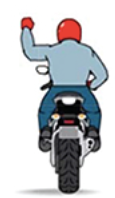
Extend your left arm out and point to the right or Bend your elbow 90 degrees, then point your clenched fist at the sky.
Stop:

Bend your elbow 90 degrees, keep your palm open, and point your fingers down to the road.
Speed Up:
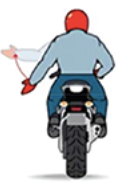
Extend arm swing palm in an upward direction.
Slow Down:

Extend arm swing palm down toward the road.
Follow Me:

Extend arm forward with the palm facing outward.
You Lean/Come:

Pull up along the side rider you want to lead, point to their bike swing arm forward.
Road Hazard:

If the hazard is on the left, point with the left finger. If on the right, point with the right foot.
Hazard: A hazard on the road refers to any condition or situation that poses a potential threat or danger to drivers, pedestrians, or other road users. Hazards can be diverse and include factors such as obstacles in the roadway, adverse weather conditions, poor visibility, uneven road surfaces, or the presence of debris. In the context of motorcycle hand signals, the signal for "hazard on the road" is typically a pointing gesture toward the hazard, alerting fellow riders or drivers to be cautious and aware of the potential danger ahead. This signal aims to enhance safety by providing timely information about road conditions and potential risks.
Single File:
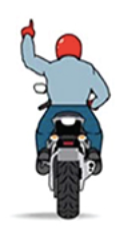
Extend arm swing palm down towards the road.
What is a Single File signal?
The "single file" signal on the road is a communication gesture used primarily in group riding situations, where a line of motorcyclists is traveling together. When a lead rider signals for "single file," it means that riders should align themselves in a single line, one behind the other, instead of riding side by side.
This signal is often used in scenarios where the road narrows, such as when approaching a construction zone, a narrow bridge, or a tight curve. Riding in a single file allows the group to navigate through restricted spaces more safely and efficiently, reducing the overall width of the group and ensuring that each rider has enough space.
When the lead rider raises their left arm and extends their index finger pointing upward, it serves as an indication for the riders to fall into a single line formation. Following this signal promotes better communication within the group, enhances safety, and helps maintain a smooth and organized ride, especially in challenging road conditions.
Double File:

Extend your left index and middle finger and bend arm up to the sky.
What is Double File signal?
The "double file" signal is a communication gesture used in group riding situations to indicate that riders should arrange themselves side by side in two rows. This signal is typically employed when road conditions allow for a wider formation, such as on open highways or roads with multiple lanes.
When a lead rider signals for "double file," it means that riders should ride beside each other in pairs, forming two columns. This formation is often used during more relaxed and open riding scenarios, providing a social aspect to the group ride.
The signal for "double file" usually involves the lead rider raising their left arm and extending two fingers, indicating the formation with two parallel rows. Riding in double file allows for increased visibility and a sense of camaraderie among the riders. However, it's important for all riders to maintain safe distances and exercise caution, especially when transitioning between formations or encountering changes in road conditions. Clear communication through hand signals enhances overall safety and coordination within the group.
Comfort Stop:
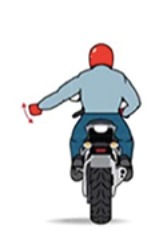
Left arm out make a fist and shake the fist with short up and down movements.
What is Comfort Stop?
A comfort stop in a ride refers to a planned break or pause during ride to provide riders an opportunity to rest, stretch their legs, use restroom facilities, and generally take a break from the journey. Comfort stops are common on long road trips where extended periods of continuous travel can become tiring or uncomfortable.
Refreshment Stop:
no image available :(
Left arm out make a "thumbs up" gesture towards your mouth.
Turn Signal On:

Alternate extending fingers and making fists.
Pull Off:
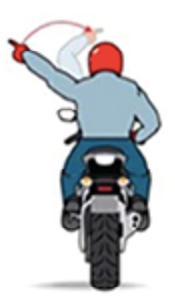
Left arm up index finger pointed, swing arm towards right. Usually emergency.
Cops Ahead:

Patting the top of the helmet with the left hand. Respect all laws when riding.
Fuel Fill Up:

Point to fuel tank using left index finger.
Motorcycle hand signals are more than just gestures; they are a silent language that unites riders across the globe. In a world filled with noise, these signals provide a clear and effective means of communication, enhancing safety and camaraderie on the open road. As riders, let's embrace and promote the use of motorcycle hand signals, ensuring that the language of the road continues to thrive for generations to come. Ride safe, Ride hard, communicate clearly, and enjoy the journey.


